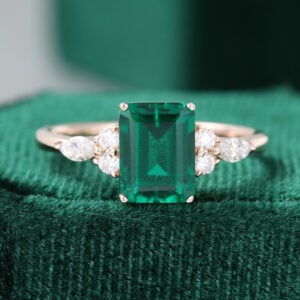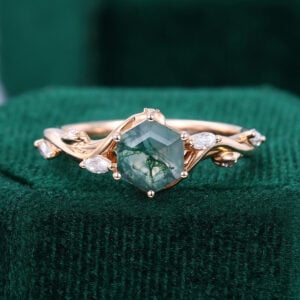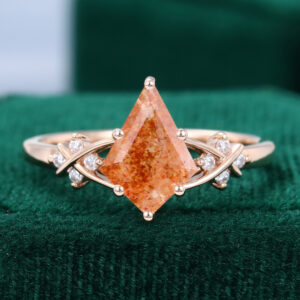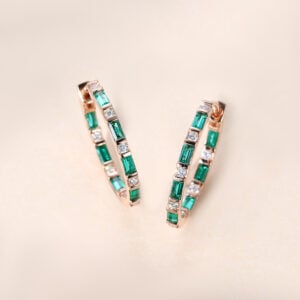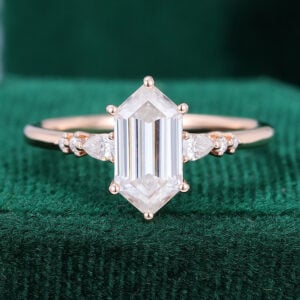Renowned for its crisp parallel facets, mirror-like clarity, and minimalist aesthetic, the step cut has become synonymous with “quiet luxury” in the jewelry world. Rather than chasing dazzling fire, it elevates a gemstone’s innate beauty through clean lines and transparent depth. From emerald to sapphire, antique treasures to modern haute joaillerie, the step cut remains a secret weapon in high jewelry. You might think the step cut is unfamiliar, but this guide will unravel its history, core features, pros and cons—and you’ll realize you’ve seen it all along.
What is a Step Cut?
The Step Cut is a gemstone cutting style characterized by rectangular facets arranged in parallel. These facets descend in layers, creating a geometric structure resembling a pyramid. The core design logic behind the step cut includes:
- Maximizing table size: Highlighting the gemstone’s clarity and color saturation.
- Weakness facet reflections: Reduce interference from fire to create an “icy” or “mirror” effect.
Step Cut Historical Evolution: From Indian Temples to Art Deco
- Ancient Origins (B.C.-16th Century)
The step cut’s origins trace back to ancient India, where artisans crudely tier-cut unpolished diamonds and emeralds for temple adornments. During the Mughal Empire (1526–1857), the flat facets of the step cut were engraved with scriptures, resulting in the unique “Indian carved gemstones” - European Refinement (17th-19th Century)
- Table Cut (17th Century): In Europe, the step cut was simplified, retaining only a large top table and bottom steps, used for early diamonds.
- Old Single Cut (18th Century): Emerging in Brazil, this variation was used for large emeralds extracted from mines. The number of facets increased to 20–30.
- Modern Standardization (20th Century-Present)
- Emerald Cut (1920s): To align with the Art Deco geometric trends, New York cutter Henry Morse standardized the step cut and first named it the “Emerald Cut”.
- Asscher Cut (1902): Designed and patented by the Asscher family in the Netherlands, this cut features a square shape, high crown, deep pavilion, and additional facets. It is often referred to as the “square emerald cut”.
Key Features of the Step Cut
1. Structural Breakdown (Using the Emerald Cut as an Example)
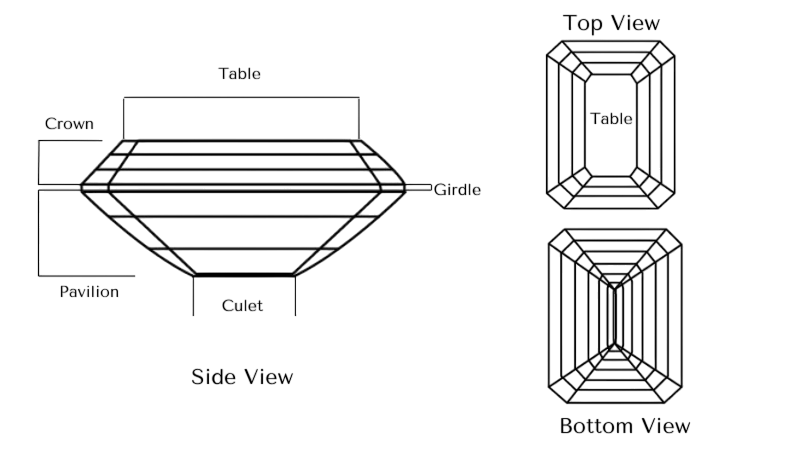
| Component | Details |
|---|---|
| Table | Large rectangular top facet, covering 60–70% of the stone, acts as a “viewing window” to showcase the gemstone’s interior. |
| Crown | 2–4 layers of parallel step facets, typically 16–24 facets in total. |
| Girdle | Relatively thick, often polished or faceted to enhance durability. |
| Pavilion | 3–5 layers of parallel step facets, typically 18–32 facets in total, with steep angles (>60°) to extend the light path. |
| Culet | Typically retains a small flat facet to avoid sharp points that could cause damage. |
2. Optical Effects
- Mirror Corridor Effect: The parallel facets form symmetrical reflective bands, creating a flowing light and shadow effect when the gemstone is moved, similar to an “infinite mirror corridor”.
- Clarity Magnifier: The large table makes internal inclusions clearly visible, requiring the gemstone to have a high clarity grade (Diamond usually VS2 or better).
- Color Enhancement: The reduction in facet reflections enhances the color of the gemstone, making it ideal for vibrant colored stones (e.g. Paraiba tourmaline, ruby, and emerald).
3. Cut Variants/Shapes
Like the brilliant cut and rose cut, the step cut can be shaped in various ways. Below are details of common step cut shapes/variants:
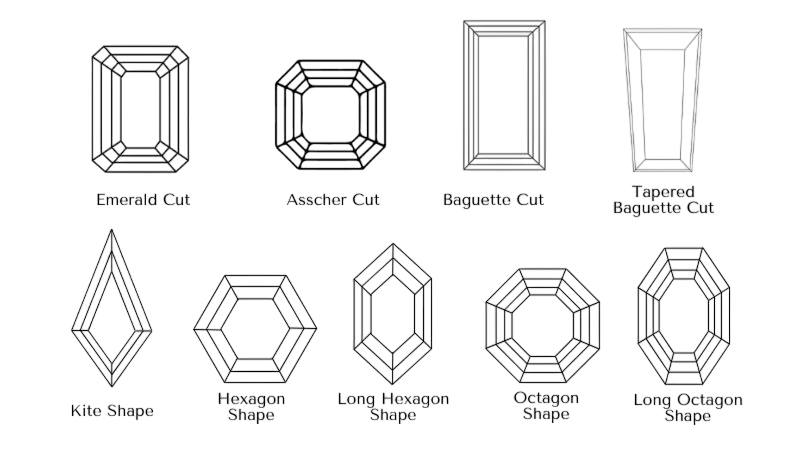
- Emerald Cut
Rectangular in outline with beveled corner cuts (typically 50-58 facets). Ideal for vintage, elegant, and minimalist styles. - Asscher Cut
A square shape with beveled corners (typically 58-74 facets), similar to the emerald cut but more symmetrical. Also known as the “square emerald cut”. Suitable for Art Deco and glamorous styles. - Baguette Cut
A slender rectangular shape (usually 14-24 facets), similar to the emerald cut but more slender with right-angled corners. Best suited for modern and minimalist styles. - Tapered Baguette Cut
A slender trapezoidal shape with sharp corners (typically 20-28 facets). Ideal for classic, vintage styles and often used as accent stones. - Hexagon Cut
Hexagonal shape, available in square and rectangular configurations, with sharp corners (typically 30-50 facets). Versatile for both modern and vintage unique styles. - Octagon Cut
Octagonal shape, like hexagons, there are square octagons and long octagons. (typically 50-58 facets). Great for vintage and elegant styles. - Kite Cut
Kite-shaped (asymmetrical quadrilateral) with sharp corners (typically 30-50 facets). Ideal for modern, avant-garde, and bold styles.
Related Reading: Emerald Cut Vs. Radiant Cut
Pros and Cons of the Step Cut
Pros:
- Maximizes Clarity and Color: The step cut highlights the clarity and color of high-quality stones, making it ideal for superior gemstones.
- Clean Geometric Lines: Its sharp, clean lines make it well-suited for modern, minimalist designs.
- Gemstone Protection: The large facets are more forgiving for brittle gemstones, reducing the risk of breaking during cutting.
- Antique Appeal: The step cut has a vintage feel, making it highly desirable for collectors.
- Ideal for Larger Stones: The step cut enhances the overall appearance of larger stones, and the elongated lines make them appear even bigger, showcasing the gemstone’s quality.
Cons:
- Weak Fire: The step cut does not produce the brilliant fire of other cuts, making it less suitable for consumers who seek sparkle.
- Exposes Inclusions: The large facets tend to reveal internal flaws, so the stone’s clarity requirements are more stringent.
- High Cutting Loss: The cutting yield is relatively low, with only 30-45% of the original stone preserved.
- Vulnerable to Damage: The sharp corners of the step cut (often right or beveled angles) are more prone to damage or chipping from impacts.
- Not Ideal for Small Stones: The step cut doesn’t highlight small stones effectively, and its visual impact is reduced in smaller gemstones.
Buying Guide: How to Choose a Step Cut Gemstone?
- Clarity Comes First
- Emeralds: Slight fissures (le jardín) are acceptable, but avoid visible black inclusions on the table.
- Diamonds: Opt for VVS1–VS2 clarity to ensure no visible flaws or interference with facet lines.
- Proportions and Symmetry
- Length-to-Width Ratio: For emerald cuts, the ideal ratio is 1.3:1 to 1.5:1, while the Asscher cut requires a strict 1:1 ratio.
- Pavilion Depth Ratio: Aim for 60–65%. Too shallow causes light leakage, while too deep may appear dark.
- Color Matching
- Colorless Diamonds: D–F color is best to avoid the yellowish tone that may be magnified by the step cut.
- Colored Gemstones: Choose stones with vibrant, saturated colors (such as pigeon blood red or royal blue). Lighter shades can appear washed out.
- Setting Protection
- V-Prong Setting: This reinforces the four corners of the rectangular gemstone, which are more prone to damage.
- Bezel Setting: A bezel can protect the vulnerable girdle, making it suitable for daily wear.
- Investment Advice
A 5ct+ high-clarity Colombian emerald (step cut) appreciates by 8–12% annually, while rare colored diamonds (such as blue diamonds) show even higher price increases.
Care Tips and Repair for Step Cut Jewelry
Different gemstones require different cleaning methods. Here are general guidelines that apply to most step-cut jewelry:
- Cleaning: Use a soft-bristled brush and mild soapy water to gently wipe the table. Avoid ultrasonic cleaning! (The sharp angles of step-cut gemstones can result in cracks or fractures if exposed to ultrasonic vibrations.)
- Storage: Store separately to avoid contact with other jewelry and prevent scratches from friction.
- Repair: Small chips or damage to the corners can be repolished, but this may reduce the stone’s size.
Step Cut Related FAQs
Is the step cut suitable for engagement rings?
Absolutely. The step cut is perfect for those seeking understated luxury. It doesn’t produce intense sparkle, instead offering a unique personality. For instance, the Asscher-cut diamond engagement ring is experiencing a resurgence, especially favored by minimalist enthusiasts.
Why are emeralds mostly step-cut?
Emeralds are brittle, and the step cut helps remove fragile corners, preventing breakage from accidental impacts. Additionally, the large table showcases the emerald’s signature “le jardín” inclusions and rich green color.
Are step-cut diamonds cheaper than round brilliant-cut diamonds?
Yes, typically 15–30% less expensive (due to lower market demand). However, top-tier Asscher-cut diamonds, especially collectible ones, can command a premium price.
Can step cut be used for semi-precious stones like Morganite?
Yes! But high-clarity raw stones are preferred, as the step cut will clearly display any flaws. Light pink Morganite in a step cut showcases a soft, “blush effect”.
What types of gemstones are best suited for the step cut?
The step cut is ideal for gemstones with high clarity or those where inclusions are part of the stone’s unique character. It also maximizes gemstone’s color, making it perfect for colored stones.
Is step-cut jewelry durable?
The step cut itself doesn’t directly impact the durability of the gemstone, different shapes have different durability. In general, the large facets of step cuts contribute to a more stable structure, making the gem more durable, but its overly sharp corners are also prone to chipping on impact.
Conclusion: The Geometry of Light, the Equation of Beauty
The step cut is the perfect balance between reason and emotion. With mathematically precise facets, it carves out a gemstone’s most authentic soul. If you’re looking for a cut that showcases a stone’s true essence, the step cut is undoubtedly the perfect choice!
Related Readings:
- All You Need To Know About Rose Cut
- All You Need To Know About Brilliant Cut
- Shallow Cut vs. Ideal Cut vs. Deep Cut


